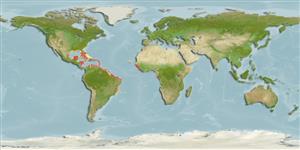Common names from other countries
Malacostraca |
Decapoda |
Xanthidae
Environment: milieu / climate zone / depth range / distribution range
Ecology
Benthic; depth range 0 - 33 m (Ref. 97531). Tropical
Western Atlantic and Eastern Atlantic: Throughout the Caribbean. Subtropical to tropical.
Length at first maturity / Size / Weight / Age
Maturity: Lm ? range ? - ? cm Max length : 1.2 cm CW male/unsexed; (Ref. 93549)
Carapace width range: 1.00 to 1.22 cm (Ref. 93549). Found on molluscan and other shells (Ref. 97531).
Life cycle and mating behavior
Maturity | Reproduction | Spawning | Eggs | Fecundity | Larvae
Members of the order Decapoda are mostly gonochoric. Mating behavior: Precopulatory courtship ritual is common (through olfactory and tactile cues); usually indirect sperm transfer.
Engstrom, N.A. 1984. (Ref. 87259)
IUCN Red List Status
(Ref. 130435: Version 2025-1)
CITES status (Ref. 108899)
Not Evaluated
Not Evaluated
Threat to humans
Human uses
| FishSource |
Tools
More information
Trophic EcologyFood items (preys)
Diet composition
Food consumption
Predators
Population dynamicsGrowth
Max. ages / sizes
Length-weight rel.
Length-length rel.
Length-frequencies
Mass conversion
Abundance
Life cycleReproductionMaturityFecunditySpawningEggsEgg developmentLarvae PhysiologyOxygen consumption
Human RelatedStamps, coins, misc.
Internet sources
Estimates based on models
Fishing Vulnerability
Low vulnerability (10 of 100).
Price category
Unknown.
